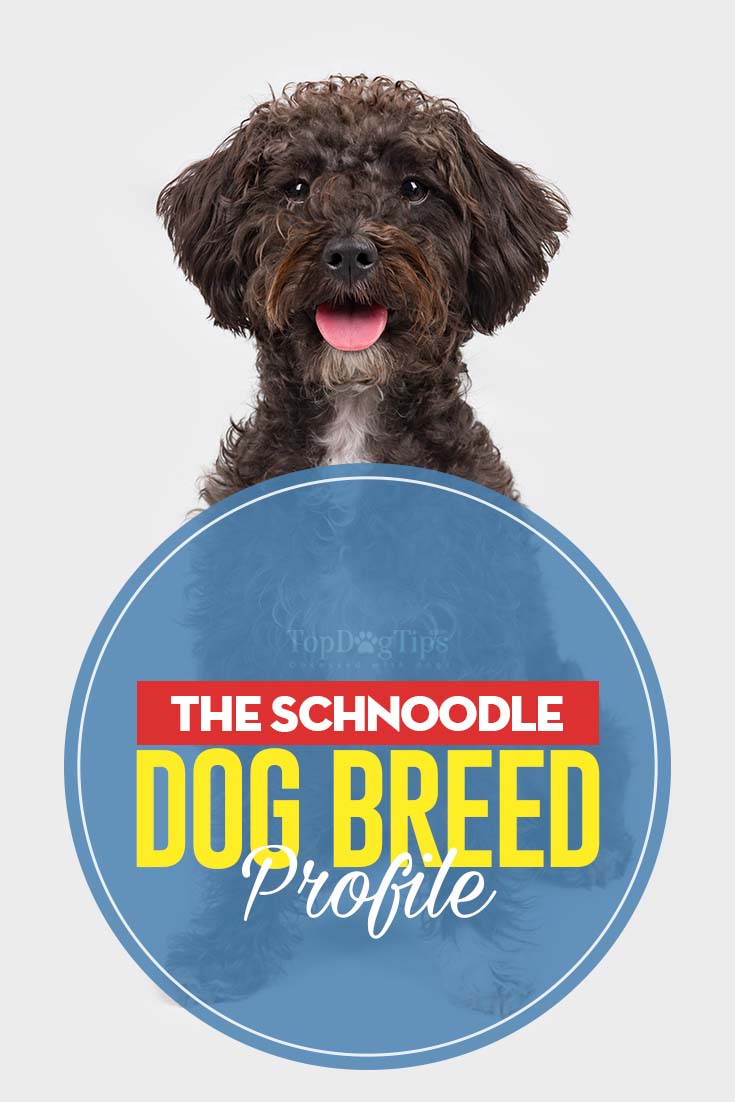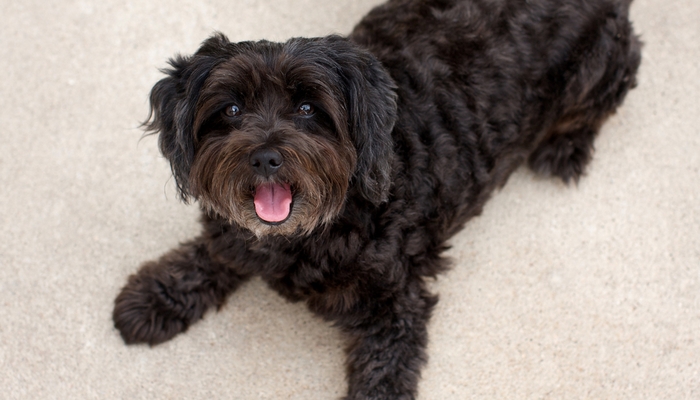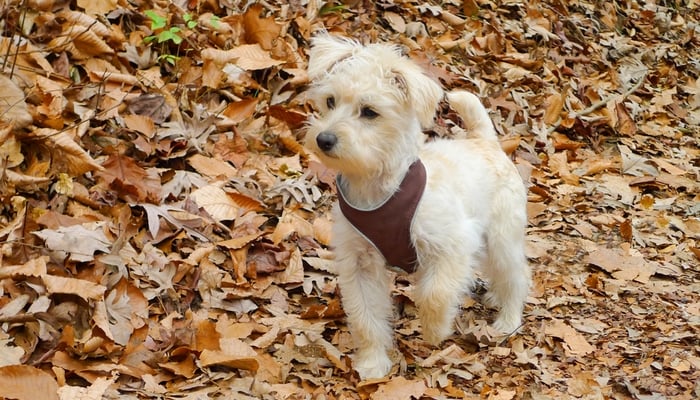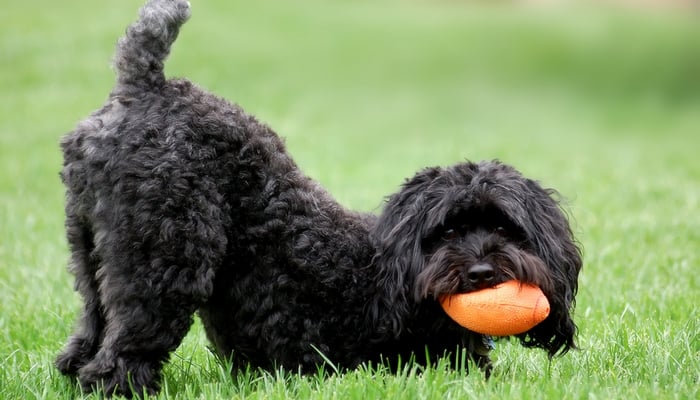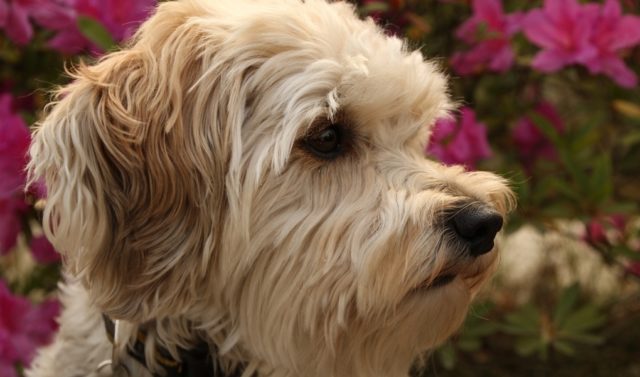
Table of Contents
Besides having a cool name, the Schnoodle dog breed is a designer pooch.
They are a fun breed that is the chosen pet of celebrities, including Claire Danes, Perez Hilton, and Dakota Fanning.
This smart pup is produced by the Poodle and the Schnauzer, which are both friendly and absolutely adorable.
These dogs must always be the center of attention regardless of whether they are at home, on stage, or in a therapy session.
Designer pooches, such as the Cockapoo, Labradoodle, Puggle, and Schnoodle dog breeds, are all first-generation litters of two purebred canines.
The idea with these specialty pets is to have your “bread buttered on both sides” with the combined best qualities from mom and dad.
If you are planning on such a designer dog, you should review the parents to get a good impression of which traits your furry friend is most likely to inherit.
Don't worry; we'll get into the parents' traits in just a minute.
The American Kennel Club (AKC) does not list Schnoodles because they aren’t officially purebreds.
However, other large kennel associations allow them to participate in certain performance events like agility, flyball, and obedience.
Schnoodles are fully recognized by the Designer Breed Registry (DBR), Designer Dogs Kennel Club (DDKC), American Canine Hybrid Club (ACHC), Dog Registry of America (DRA), International Designer Canine Registry (IDCR), and Continental Kennel Club (CKC).
This breed debuted in Minnesota in the 1980s, with the demand for Poodle mixtures booming into the next decade.
The first versions of the smaller Schnoodles, Truffle Dogs, were believed to be bred between Toy Poodles and Terriers.
As the name suggests, this breed was created to sniff out the coveted forest delicacies.
Schnoodle Dog Breed Information: Meet the Parents
The Schnoodle dog breed is a cross between a thoroughbred Schnauzer and a Poodle.
This is where the name is cleverly derived from.
Second-generation litters (when both the mother and father are Schnoodles themselves) are becoming more regular nowadays.
There are certain characteristics of the Schnoodle that come from one side of their lineage or the other.
Getting to know a bit about the parents can help you understand this hybrid breed.
The Schnauzer
The oldest variety of Schnauzer is the Standard, with the Miniature and Giant following, respectively.
The two larger variations are recognized as a working dog breed by the American Kennel Club (AKC), with the petite Schnauzer falling into the terrier group.
The medium-length hair of the Schnauzer is soft in puppyhood, but it becomes wiry over time. The Giant is known to have shorter hair.
Shades of the Schnauzer differ, with the most common being plain black, salt-and-pepper, or a combination of black and silver.
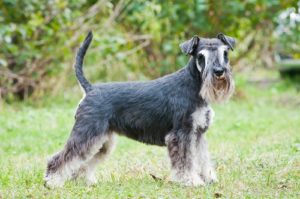 These dogs have an awesome mustache, muzzle, and bushy Einstein eyebrows that are often left long and untrimmed, even if the body is shaved.
These dogs have an awesome mustache, muzzle, and bushy Einstein eyebrows that are often left long and untrimmed, even if the body is shaved.
Their name is adeptly derived from the German word Schnauze, which translates as muzzle or snout.
These dogs are stocky and thick-boned with a square-shaped body.
Giant Schnauzers weigh 65 to 90 pounds and measure 23½ to 27½ inches.
The Standard Schnauzer measures 17½ to 19½ inches and weighs about 35 to 45 pounds.
The Miniature Schnauzer is lightweight at a mere 13 to 15 pounds and a height of just 12 to 14 inches.
All-sized Schnauzers are playful and rambunctious.
Children don’t pose problems with these active pets that also make great watchdogs.
They can have a slight stubborn streak on occasion, but training will not become a problem if they enjoy the activity.
A common malady with these dogs is Schnauzer Comedone syndrome, a skin condition of inflammation around the hair follicles.
Other frequent health problems are Von Willebrand’s Disease, Progressive Retinal Atrophy (PRA), and urinary stones.
Hip dysplasia is prevalent in the larger Schnauzer varieties.
Gastric torsion, also known as GDV, is another common health condition seen in this breed.
RELATED: 20 Most Friendly Dog Breeds In the World
The Poodle
There are three Poodle varieties, but this is more about the size and not about breeding.
They are one of the world’s most favored pets.
Poodles were registered in the late 1800s by both the English and American Kennel Club within a few years of each other.
These dogs have gorgeously curling coats of uniform color, which make them prime candidates for dog shows.
Although they do not shed, their luxuriant and soft coats require more maintenance regarding brushing, bathing, and trimming.
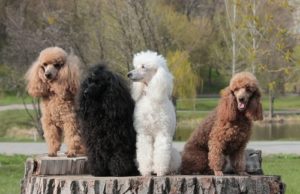 They come in a wide variety of colors, including black, white, blue, gray, silver, red, and brown. Unique shades of cream, apricot, and a lighter brown shade nicknamed café-au-lait are also possibilities.
They come in a wide variety of colors, including black, white, blue, gray, silver, red, and brown. Unique shades of cream, apricot, and a lighter brown shade nicknamed café-au-lait are also possibilities.
The Standard Poodle is around 15 to 22 inches tall with a mass of 45 to 70 pounds in the males.
The fairer sex weighs about 10 pounds less at her heaviest.
Miniature Poodles have a minimum height of 10 inches and a maximum of 15″, weighing 15 to 18 pounds.
The Toy Poodle is only 6 to 9 pounds and a mere 10 inches at its tallest.
As with the Schnauzer and their hybrid offspring, Poodles are clever and fun-loving.
Sometimes, this may even border on naughtiness when they are not stimulated enough, both physically and mentally.
These dogs are overall quite calm and well-mannered when properly trained, especially in obedience.
The Poodle shares several health concerns with the Schnauzer.
Progressive Retinal Atrophy (PRA) and Von Willebrand’s disease are two of the shared health concerns.
Hip dysplasia is another shared concern, but the Poodle can also get it in their elbows.
It is necessary to wipe this pooch’s face every day with pet-friendly wipes that contain no alcohol or a dampened cloth.
Their eyes weep regularly, causing reddish-brown staining. This trait is often passed on to the Schnoodle dog breed.
Other medical concerns that may be passed on to their offspring include epileptic attacks, gastric dilatation-volvulus (bloat), Sebaceous Adenitis (SA), hypothyroidism, Legg-Calvé-Perthes, patellar luxation, and hypoadrenocorticism.
SIMILAR: 30 Breeds That Are Good House Dogs & Perfect for Families
Understanding the Basics of a Schnoodle
Each of the different types of Schnauzers and Poodles have their own characteristics.
The appearance and even the overall personality of your Schnoodle will depend greatly on the individual parents.
Even within a single litter, the babies' size and looks can vary greatly.
Appearance
The coat of the Schnoodle is usually fine with medium-length hair.
Ideally, their coats are meant to be silky, soft, and wavy.
Those that lean more toward the genetics of the Schnauzer, particularly in the Giant variety, may have more wiry hair and denser coats found in later years.
On the Poodle side, your dog may have this breed's signature tightly curled coat.
The Schnoodle dog breed sheds very little, if at all.
They are, therefore, marketed as suitable for those who suffer from allergies.
A lesser-known fact is that people allergic to animals are not allergic to the hair. The sensitivity is actually caused by dander, which is the shedding of dead skin cells.
Shades of the Schnoodle vary from uniform black, brown, gray, silver, apricot, sable, and white.
Combos include gray and silver, tan markings on black, or white markings on black. Their coloring is noted to change over the years.
The Schnoodle is square-shaped, like both parents.
He could have a straight back or one that slopes gently from the shoulders down to the tail.
The ears of the Schnoodle are medium in size and tend to fold over in a distinctive “V.”
They are very emotionally expressive and will lift one or both ears depending on their mood.
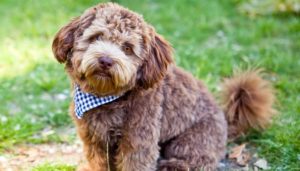 Their heads are medium in width, becoming narrower to the muzzle but not as prominently as the Poodle.
Their heads are medium in width, becoming narrower to the muzzle but not as prominently as the Poodle.
They commonly exhibit the Schnauzer’s characteristic cat feet.
Tails are usually held up in the air, indicating that the dog is content.
When the opposite is true, or your Schnoodle is edgy, you will find them walking with their tail between their legs.
Giant Schnoodles
This is the newest edition to the Schnoodle dog breed family.
The traits gained by the crossing of a Giant Schnauzer and a Standard Poodle are still largely unknown, as these pups are few and far between.
These big dogs come in at a hefty 60 to 85 pounds and are 24- to 28-inches high.
Standard Schnoodles
Also not as old in the Schnoodle history as the smaller version is the Standard Schnoodle. It is a cross of two Standard parents.
They weigh anywhere between 20 to 75 pounds and are 16- to 26-inches tall when measured from the shoulder.
Miniature Schnoodles
The parents, in this case, are a Miniature Poodle and a Miniature Schnauzer.
In terms of height, these pooches are 12- to 16-inches tall and weigh in at 14 to 20 pounds.
Toy Schnoodles
Adorably nicknamed “Teddybear Schnoodles,” these canines are the product of a Miniature Schnauzer and a Toy Poodle.
These itsy-bitsy pups weigh only 6 to 14 pounds and are 8- to 12 inches high at the withers.
This makes them perfect handbag companions for those who love toting their pooch along with them wherever they go.
Personality
Once more, the individuality of your furry friend and his parents will affect his overall personality.
Hybrids are often difficult to predict, but in general, these dogs are smart, perpetually young at heart, and enjoy playing.
They are affectionate, protective of their owners, and sociable creatures.
At best, they are not as hard-headed as the Schnauzer and are a little less energetic, like the Poodle.
Who Would be a Suitable Owner?
Anyone will make a great Schnoodle dog breed owner.
They are ideal for inexperienced owners, as well as for those who live alone or in families.
They adapt easily to your lifestyle as long as you make sure they get enough exercise and tons of playtime.
Although they get on well with the family, Schnoodles have the tendency to favor one human more than others.
Take them with you when running errands in your car as a treat. They love this!
Smaller Schnoodles do well in apartments, but the larger ones definitely require a fenced yard.
This is actually better for all Schnoodles, as they like to frolic and can chase their own tails in circles for what seems like hours on end.
Schnoodles are inside dogs.
They do not thrive when being left outside or for extended periods on their own as some suffer from separation anxiety.
RECOMMENDED: How To Deal with Separation Anxiety In Dogs?
How Will My Dog React To Other People and Pets?
Due to their lighthearted nature, children and Schnoodles will get on like a house on fire.
The only time this may be tricky is if you are adopting an older dog that is being introduced to little ones for the first time.
While they still aren't an extremely common breed, owners say the Toy Schnoodles seem to get on better with older children than toddlers.
Always supervise playtime between children and your pets.
Ear and tail tugging or approaching the dog when sleeping or eating is never a good idea. This goes for all pooches and not just the Schnoodle.
Schnoodles make superb watchdogs and are known for their tremendous protectiveness.
They are guaranteed to alert you by barking if someone unknown is in the vicinity.
Although these dogs are normally not aggressive in nature, it is best to introduce them to new people by having visitors over often or taking them on routine excursions to the park.
If introduced to other household pets from puppyhood, there should not be any problems.
This includes cats, for the most part, although smaller critters like rabbits or birds may be chased.
Make sure your Schnoodle has his own toys. They don’t like to share, and this is even more so when it comes to their food bowls.
In the smaller versions, if they have terrier traits, the Schnoodle dog breed may play quite hard and be distrustful of other dogs.
Activities to promote socialization (particularly puppy classes) are recommended.
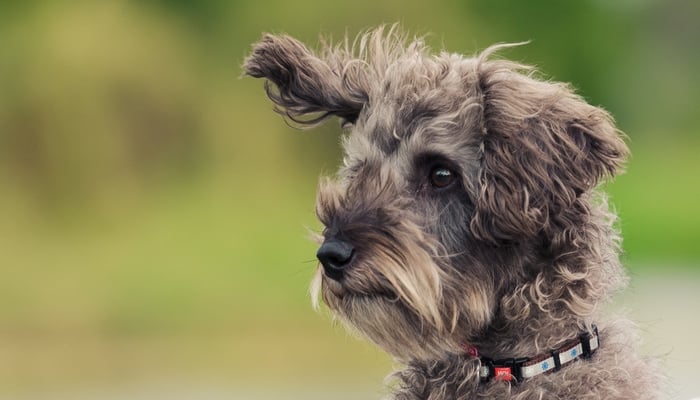
Schnoodle Dog Breed Training and General Care
As they are blessed in the brain department, these dogs are quick to catch on when training and endless repetition are not required.
It also helps that they are people pleasers. They are attentive and quick to obey.
It is best to start training the day you bring your Schnoodle home.
The Schnoodle is quite sensitive, so positive reinforcement when training works best.
Unless they get this attribute from the Poodle, Schnoodles are not noisy. If they do have this proclivity, training from a young age will prevent excessive barking from becoming a habit.
Schnoodles will bark when there is an intruder, and they will tend to voice their displeasure when they are bored or lonely.
Another outlet for them here would be to act out in a destructive manner.
For these reasons, Schnoodles are best suited for a home where they would not be left alone for long periods of time every day.
Taking Care of a Schnoodle
The life expectancy of the Schnoodle dog breed is 10 to 15 years, with an average of 13 years.
This is considered the norm for both parental breeds as well.
If you're considering adopting one of these dogs, you must understand that it is a long-term commitment.
Brushing
The amount of attention you give to your Schnoodle’s coat will depend on which parent's characteristics he has.
If they have the wiry coat of a Schnauzer, they need minimal grooming and only weekly brushing to remove dead skin cells.
 If he has the softer, wavy hair of a Poodle, you can expect some tangling and matting. To prevent this, your furry friend will need brushing more often.
If he has the softer, wavy hair of a Poodle, you can expect some tangling and matting. To prevent this, your furry friend will need brushing more often.
Optimally, this should be at least bi-weekly. Schnoodles with silky coats must be brushed after every bath.
To prevent excessive matting of the fur, use a hairdryer.
As with the Schnauzer, the mustache and bearded look suits the Schnoodle.
Make sure to keep this crumb-free and clean with regular trimming.
Trimming is necessary every month to two months if their coats are curly or wavy.
This is simple enough for a do-it-yourselfer. (Check out the video guides listed below for more information)
You'll also need to brush your dog's teeth several times a week to prevent gingivitis and the build-up of tartar.
Issues of the gum and teeth are more common in the Toy Schnoodle, but they are found in every variation of the breed.
Schnoodles tend to have the Poodle problem of staining under the eyes as well.
Prevent this by cleaning their faces every day. Their ears must be kept clean and dry on a regular basis, too.
Any sign of a smell or redness is a sign of infection. Additionally, healthy ears require the regular trimming of hair in this area.
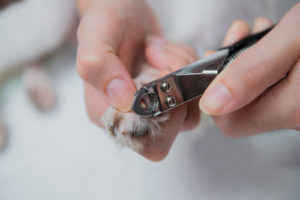 Nails should be trimmed at least every week or two to prevent snagging. The Schnoodle will get excited when you come home, and he may inadvertently hurt you when jumping up to greet you.
Nails should be trimmed at least every week or two to prevent snagging. The Schnoodle will get excited when you come home, and he may inadvertently hurt you when jumping up to greet you.
Finally, it is a topic that most owners don't even think about.
The Schnoodle dog breed needs the hair around his private areas trimmed regularly, as an odor can be caused by accumulated urine.
It is also not uncommon for feces to stick to the bottom area as well.
For more detailed information on these specific dog grooming tasks, you can check out Top Dog Tips' helpful video grooming guides, including:
- How To Stop Dogs From Shedding
- How To Bathe A Dog
- How To Brush A Dog's Teeth
- How To Clean A Dog's Ears
- How To Clean Dog Tear Stains
- How To Cut A Dog's Nails
Health Concerns of the Schnoodle Dog Breed
Common in both the Poodle and Schnauzer, hip dysplasia causes an abnormality in the hip socket’s formation.
As mentioned above, Leg-Calvé-Pethese Diesease is common in the Schnoodle dog breed as well.
With this condition, blood circulation is limited, which causes the disintegration of the femur and the hip joint at the pelvis.
Progressive Retinal Atrophy (PRA) is another common condition seen in this breed.
The late stages of PRA can result in complete blindness.
It is common in both breeds of parents, making it very common in the Schnoodle.
Another eye condition often seen in these dogs is cataracts.
This milky overlay on the eye, which occurs in the twilight years, will affect vision and can usually be removed during surgery.
Skin conditions seen in the Schnoodle include sensitivity, allergies, or dry/oily seborrhea.
The latter is a lesser-known condition that produces itchiness and scaling of the skin.
Other health risks that are sometimes seen in this breed and can be very serious include:
- Slipped Stifles (also known as patellar luxation)
- Addison’s Disease
- Idiopathic Epilepsy
- Diabetes Mellitus
- Gastric Torsion
Exercise for Schnoodles
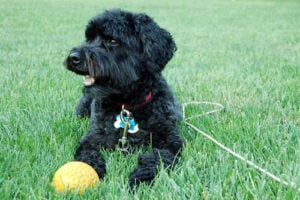 The Schnoodle is fairly active and needs at least 60 minutes of daily exercise. They make super jogging partners, but if you are not that sporty, brisk walks to the park will work just as well.
The Schnoodle is fairly active and needs at least 60 minutes of daily exercise. They make super jogging partners, but if you are not that sporty, brisk walks to the park will work just as well.
Play, play, and play! Think to catch, fetch, tag, or tug-of-war.
This is a fun way for your Schnoodle to burn energy.
Please bear in mind that these dogs are intelligent, so they do not only need physical stimulation but mental activities as well.
Where Do I Get My Schnoodle?
Any type of purebred pup should be purchased from a reputable breeder.
Because the Schnoodle is a hybrid of two purebred breeds, they are much less common and will not likely be found in shelters or at rescue organizations.
Consult with associations if you are not sure if there is a Schnoodle breeder in your area.
The reason that it is so important to find a reputable breeder is that thoroughbreds may develop certain diseases that are genetic.
Good parent matching can eliminate some of these, and the breeder should also provide you with a clearance certificate from the necessary medical centers.
Many Schnoodle parents who have adopted their pets from a rescue group have found this to be extremely rewarding.
If you have it in your heart, extra patience, and the means to provide a neglected pooch with a good home, this is one option worth considering.
Just remember that it may take a while to find a rescue Schnoodle that needs you.
READ NEXT: 30 Most Popular Dog Breeds That Are Famous All Over the World
